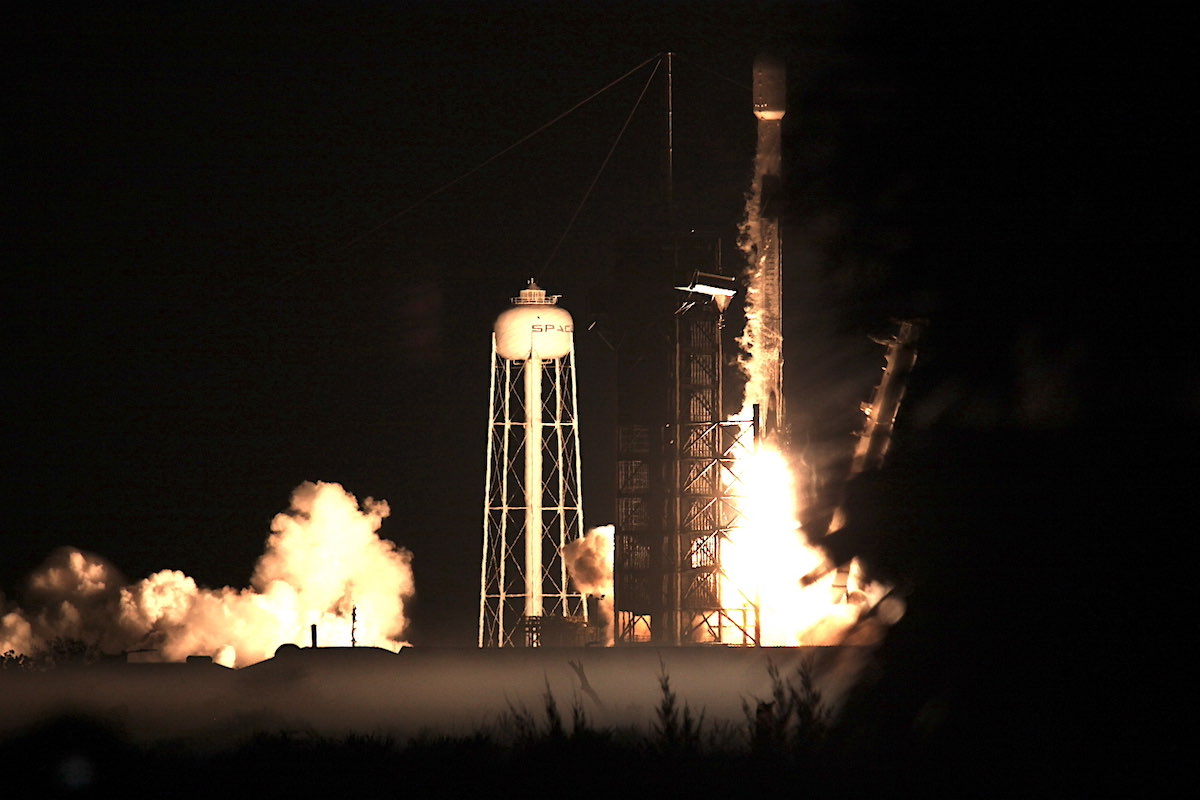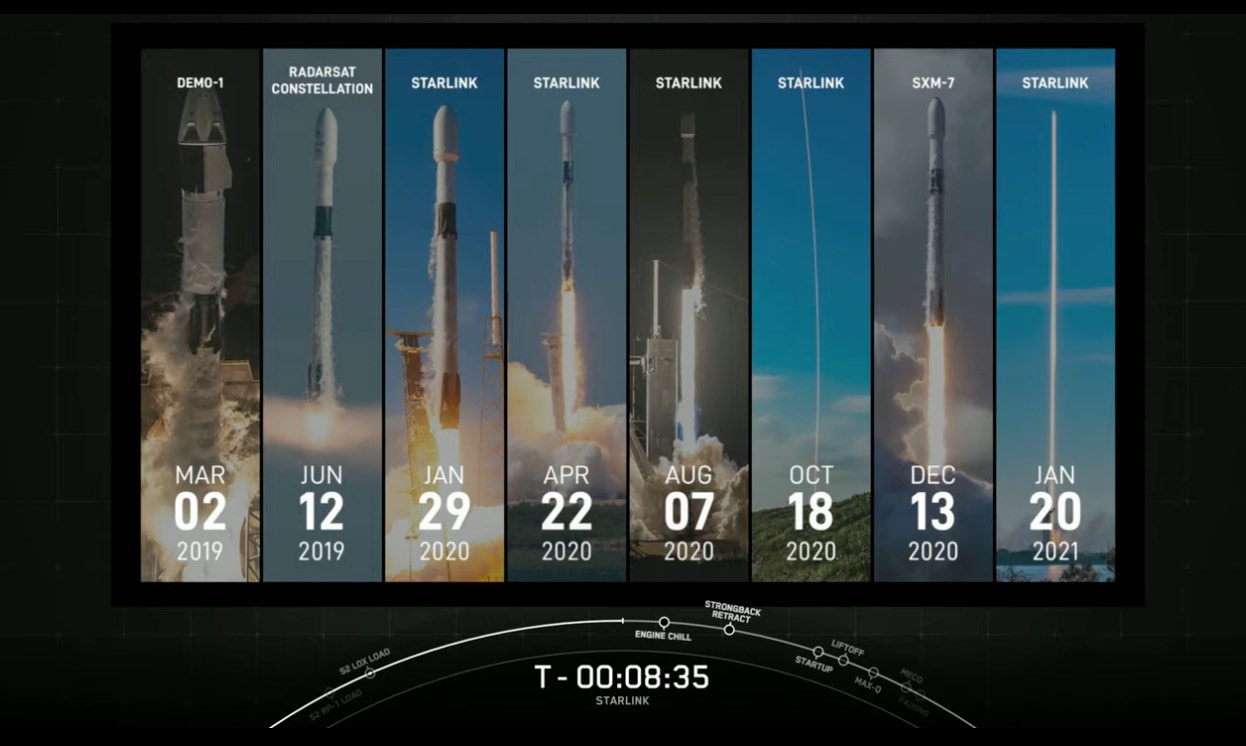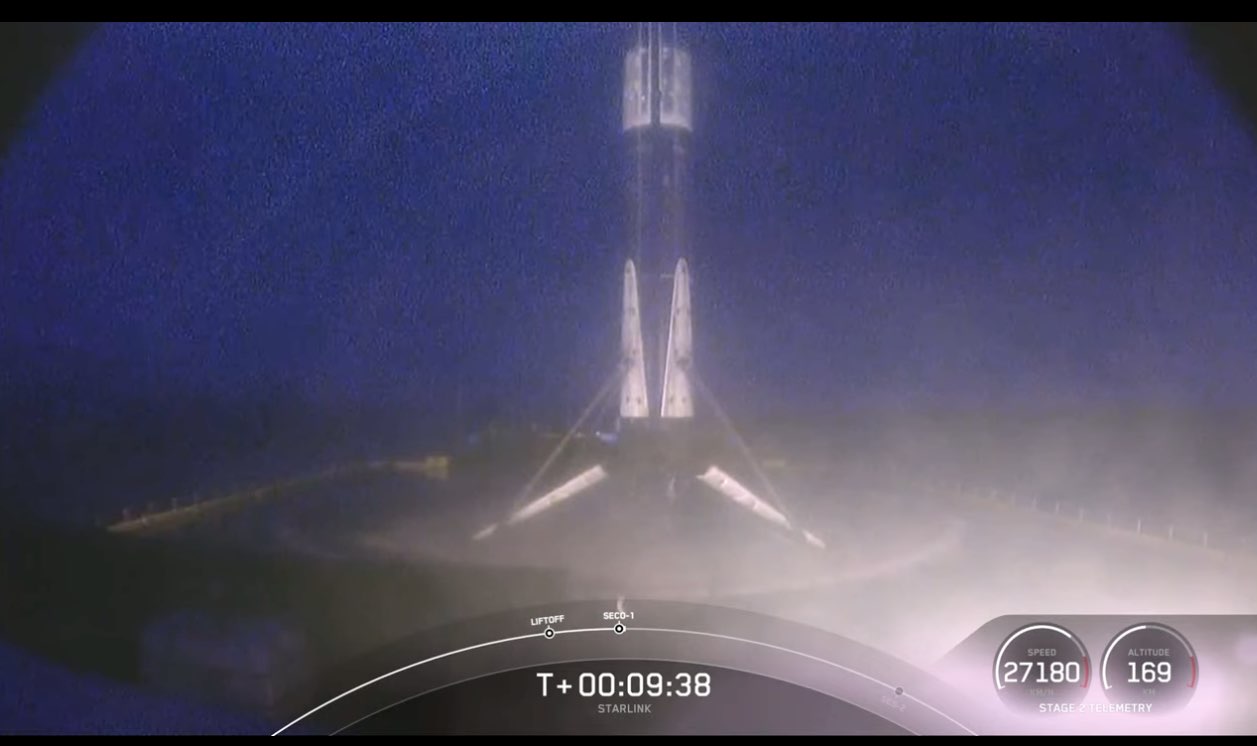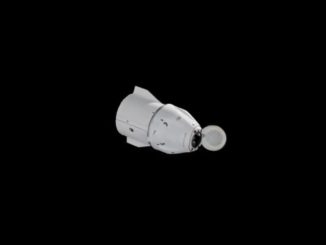
Using a Falcon 9 booster flying for a record ninth time, SpaceX’s swift sequence of launches continued Sunday with a predawn liftoff from the Kennedy Space Center carrying another set of 60 Starlink internet satellites, the company’s third mission in 10 days.
The 229-foot-tall (70-meter) Falcon 9 rocket climbed away from pad 39A at Kennedy and arced toward the northeast and propelled its 17-ton (15.6-metric ton) payload into space.
The launcher took off at 6:01:26 a.m. EST (1001:26 GMT) powered by nine kerosene-fueled Merlin main engines to kick off SpaceX’s eighth Falcon 9 launch of the year.
The Falcon 9 vaulted into the early morning sky with 1.7 million pounds of ground-shaking thrust.
The launch was the third Falcon 9 flight in 10 days from two Florida launch pads a few miles apart. The two previous Falcon 9 flights March 4 and March 11 each carried 60 Starlink satellites into orbit.
The launch Sunday was a near carbon copy of the two missions earlier this month, flying with a reused Falcon 9 booster, a recycled payload shroud, and a stack of flat-panel Starlink spacecraft.
But the mission set a new record for SpaceX’s rocket reuse program. The Falcon 9 rocket’s first stage booster — designated B1051 — made its ninth trip to space and back, the first vehicle in SpaceX’s inventory to log so many missions.
Another booster in SpaceX’s fleet has eight missions to its credit.
The booster on Sunday’s launch debuted in March 2019 on a mission carrying SpaceX’s first Crew Dragon spaceship on an unpiloted test flight to the International Space Station. Since then, the booster has launched a constellation of Canadian Radarsat observation satellites from California, followed by six more missions from Florida.

The booster appeared to perform flawlessly again Sunday. Its nine Merlin main engines shut down about two-and-a-half minutes into the mission, then the stage separated to begin a descent toward SpaceX’s drone ship “Of Course I Still Love You” in the Atlantic Ocean.
The 15-story booster touched down vertically on the football field-sized floating platform around 400 miles (630 kilometers) northeast of Cape Canaveral about eight-and-a-half minutes after it took off.
The Falcon 9’s upper stage, meanwhile, guided the 60 Starlink satellites into orbit. Two firings of the upper stage’s single Merlin engine injected the satellites into an on-target orbit, SpaceX said.
The rocket released the satellites all at once at an altitude of 175 miles (283 kilometers) at 7:05 a.m. EDT (1105 GMT), about 64 minutes after blasting off from the Kennedy Space Center.
With Sunday’s launch, SpaceX has sent 1,325 Starlink satellites into orbit on a series of Falcon 9 missions. Some of those satellites were prototypes and have re-entered the atmosphere and burned up. Jonathan McDowell, an astronomer at the Harvard-Smithsonian Center for Astrophysics and a respected tracker of spaceflight activity, said SpaceX currently had about 1,200 Starlink satellites in orbit before Sunday’s mission.
The launch Sunday was SpaceX’s 22nd dedicated Falcon 9 mission with Starlink satellites.
The Starlink network could eventually number more than 10,000 satellites, but the first tranche of Starlinks will have 1,584 satellites orbiting 341 miles (550 kilometers) above Earth on paths tilted 53 degrees to the equator. SpaceX has approval from the Federal Communications Commission for around 12,000 Starlink satellites at a range of altitudes and inclinations, all within a few hundred miles of the planet. The low altitude enables the satellites to deliver high-speed, low-latency connectivity to customers, and helps ensure the spacecraft naturally re-enter the atmosphere faster than if they flew farther from Earth.
Starlink is already providing interim beta service across high latitude regions, such as the northern United States, Canada, and England. More Starlink launches this year will enable an expanded coverage area.
SpaceX announced earlier this month that the Starlink beta service will soon begin reaching customers in Germany, New Zealand, and in other regions of the United Kingdom, including Wales, Scotland, Northern Ireland, and northern England. Those areas could receive beta service in the “coming weeks,” SpaceX said.
SpaceX is accepting pre-orders from would-be Starlink consumers, who can pay $99 to reserve their place in line to get Starlink service when it becomes available in their area. For people in the southern United States and other lower-latitude regions, that should come by late 2021, SpaceX says.

Once confirmed, customers will pay $499 for a Starlink antenna and modem, plus $50 in shipping and handling, SpaceX says. A subscription will run $99 per month.
The Starlink satellites are built by SpaceX in Redmond, Washington, and each spacecraft weighs about a quarter-ton at liftoff. They are fitted with power-generating solar array wings, krypton ion thrusters for propulsion, and visors to dim their brightness to people on the ground, a mitigation added to Starlink satellites last year after astronomers raised concerns the spacecraft would ruin some telescopic observations.
Like previous Starlink launches, the satellites deployed Sunday separated from their Falcon 9 launcher Sunday in a lower-altitude transfer orbit, then will use their ion thrusters to move higher into the operational Starlink fleet at 341 miles altitude.
SpaceX’s recovery team will return the drone ship with the Falcon 9 booster to Port Canaveral in the coming days for inspections and refurbishment ahead of a potential 10th flight. Boats were also stationed downrange to retrieve the two halves of the Falcon 9’s payload fairing, which dropped away from the rocket after it soared above the dense, lower layers of the atmosphere.
Miss this morning’s Falcon 9 launch?
Here’s a replay of the Falcon 9 climbing off pad 39A at NASA’s Kennedy Space Center with 60 more Starlink internet satellites.
Continuing coverage: https://t.co/b7ASn9DfQ1 pic.twitter.com/dRuto5b6Bv
— Spaceflight Now (@SpaceflightNow) March 14, 2021
SpaceX officials have said the most recent version of the Falcon 9 booster can make 10 flights with only inspections and minor refurbishment in between missions. With an overhaul, the Falcon 9 Block 5 boosters could fly 100 missions, SpaceX founder and CEO Elon Musk has said.
Hans Koenigsmann, a senior advisor and former vice president at SpaceX, said last month he believes the 10-flight limit is not a “magic number.”
“We’ve learned a lot about refurbishment,” he said during a Feb. 23 panel discussion at the 47th Spaceport Summit. “We’re learning … what to pay attention to and maybe some of these are obvious. We want to take care of the heat shield. There are some engine components that need, on a regular basis, a degree of inspection to make sure the seals are working, and so on and so forth. So we’ve been learning with every single landing.”
The Starlink network is driving SpaceX’s high tempo launch cadence. Koenigsmann said SpaceX will soon reach the 10-flight mark with one of its Falcon 9 boosters.
“I’m pretty sure we will get to 10 flights soon, and then we will continue to look at the booster and make an assessment (whether) we can move forward with it,” he said. “My personal opinion is that we will probably continue until we see more damage on the booster.”
Koenigsmann said SpaceX will look at data rather than specifying a certain number of flights for each booster.
“We will inspect them regularly, at regular intervals” he said. “And the next time you check that the engine held up and see if there’s any damage there. To me, it is an engineering problem. I don’t think the number of 10 is a magic number.
“Also, for example, we could start phasing in new components at some point in time and actually extend the life of the booster,” Koenigsmann said.
SpaceX is preparing for another Falcon 9 launch from pad 40 at Cape Canaveral Space Force Station next Sunday, March 21, at 12:37 a.m. EDT (0437 GMT) with the next batch of Starlink satellites.
Email the author.
Follow Stephen Clark on Twitter: @StephenClark1.



